
1841
Pierre-Auguste Renoir is born on 25 February in Limoges, the sixth of seven children. His father, Léonard Renoir, is a tailor, and his mother, Marguerite Merlet, a dressmaker.
1845
The Renoirs move to Paris; Renoir attends a primary school run by the Frères des Écoles chrétiennes.
-

1854–58
Renoir is apprenticed to a porcelain painter. He takes drawing lessons at the École gratuite de dessin, a free drawing school that also provides instruction in the decorative arts.
1859
Renoir works briefly as a decorator for a manufacturer of blinds, specializing in imitations of stained glass windows for churches.
1861
He registers with the established Salon painter and teacher Charles Gleyre, whose private atelier prepares students for entry in the École des Beaux-Arts, the state-sponsored art school. At Gleyre's atelier his fellow students include Claude Monet, Frédéric Bazille, Alfred Sisley, and James McNeill Whistler.
Renoir receives permission to study at the Louvre and the Print Room of the Bibliothèque Nationale.

1862–64
Renoir is admitted to the École des Beaux-Arts and participates in the school's drawing examinations. He places twenty-eighth in a class of eighty in October 1863, and tenth out of 106 candidates in April 1864.
In March 1863, he submits his first work to the Salon, held every year at the Palais de l'Industrie on the Champs-Élysées. His large horizontal painting Nymph and Faun is rejected; Renoir destroys the canvas.
May–June 1864, Renoir's Esmeralda—a large horizontal painting showing Victor Hugo's heroine dancing in front of Notre-Dame Cathedral—is
accepted by the Salon.
1865
Two pictures are accepted at the Salon.
1866
In April Renoir submits a full-length painting of two female bathers in a landscape and a smaller work to the Salon. The large Bathers is rejected, but the jury accepts the lesser submission, which Renoir then withdraws.
-

Diana the Huntress
National Gallery of Art, Washington, D.C.
1867
Renoir's full-length Diana the Huntress, modeled for by his mistress, Lise Tréhot, is rejected by the Salon jury in March 1867.
-

Lise with a Parasol
Folkwang Museum, Essen
1868
The artist exhibits the full-length Lise with a Parasol at the Salon of 1868. It is well reviewed and caricatured in the press; Renoir waits five years before being able to sell it.
-

1869
He works during the summer with Monet at La Grenouillère, a bathing and boating establishment outside Paris. Their experiments in capturing the fleeting effects of water and sunlight in an abbreviated, highly colored style initiate the new pictorial language of Impressionism.
-
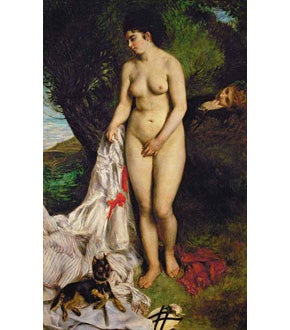
Bather with a Griffon
Museu de Arte de São Paolo Assis Chateaubriand
1870
In May Renoir exhibits two large canvases at the Salon: Bather with a Griffon and Woman of Algiers (National Gallery of Art, Washington, D.C.).
Lise Tréhot gives birth to their daughter, Jeanne Marguerite (1870–1934), with whom Renoir will
establish contact only after 1892.
-

1870–71
Following France's declaration of war against Prussia in July 1870, Renoir is mobilized in the Tenth Cavalry Regiment. He returns to Paris in April 1871.
-
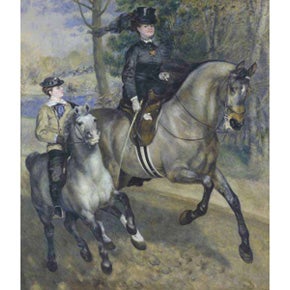
Riding in the Bois de Boulogne
Kunsthalle, Hamburg
1872
Renoir's large Parisian Women in Algerian Dress — the last picture for which Tréhot models — is rejected by the Salon jury. With Manet, Pissarro, and Cézanne, he signs a petition to Charles Blanc, Directeur des Beaux-Arts, demanding a Salon des refusés.
During the winter of 1872–73, Renoir is at work on Riding in the Bois de Boulogne, a monumental scene of Parisian high life, measuring 260 by 220 centimeters. It is the largest work he will ever paint.
-

1873
After the rejection of Riding in the Bois de Boulogne by the Salon jury, Renoir exhibits it at the Salon des refusés held in May–June in a makeshift pavilion opposite the Palais de l'Industrie.
In the summer and autumn Renoir regularly visits Monet and his family in their home at Argenteuil; the painters work together outdoors on shared motifs.
-
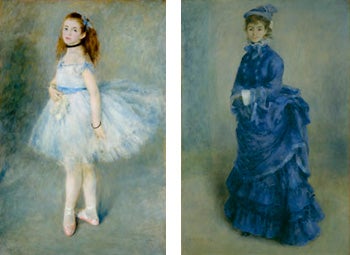
The Dancer
National Gallery of Art, Washington, D.C.
La Parisienne
National Museum Wales, Cardiff
1874
Renoir is among the founding members of the Société Anonyme des Artistes. Between 15 April and 15 May the group mounts its first exhibition in the former studio of the photographer Nadar. Renoir sends six paintings to this inaugural Impressionist exhibition and is also responsible for its installation. His two largest submissions — The Dancer and La Parisienne — are on display in the East Gallery.
-

1875
On 24 March Renoir participates in a group auction of recent Impressionist paintings at the Hôtel Drouot; twenty of his works sell for just over 2,000 francs.
-
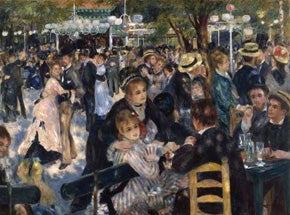
Ball at the Moulin de la Galette
Musée d'Orsay, Paris
1876
Renoir submits seventeen paintings to the Second Impressionist Exhibition. La Promenade, painted during the winter of 1875–76, is his most ambitious work and forms the centerpiece of his installation.
Between May and October, Renoir rents a house and garden in Montmartre, where he works on the large horizontal composition, Ball at the Moulin de la Galette, which will form the centerpiece of his submission to the Third Impressionist Exhibition the following spring.
-

1877
Renoir organizes a second Impressionist auction at the Hôtel Drouot on 28 May; fifteen of his paintings and a pastel sell for just over 2,000 francs.
-

Madame Charpentier and Her Children
The Metropolitan Museum of Art, New York
The Portrait of Jeanne Samary
State Hermitage Museum, St. Petersburg
1878
Renoir begins to attract the support of wealthy patrons such as the publisher Georges Charpentier and his wife, Marguerite Charpentier, and the Protestant banker Paul Berard; their portrait commissions will eventually transform his economic situation.
He withdraws from the Impressionist exhibition that had been planned to coincide with the Exposition Universelle in May 1878 and instead sends to the Salon the modestly sized Le Café (private collection).
In October Renoir completes two large paintings intended for the next year's Salon: Madame Charpentier and Her Children and The Portrait of Jeanne Samary.
-

Mussel Fishers at Berneval
The Barnes Foundation, Philadelphia
1879
Thanks to the influence of his patron, Renoir's portrait of Madame Charpentier and Her Children is hung in a place of honor at the Salon of 1879 and well reviewed by the critics; his Portrait of Jeanne Samary is hung high and receives hardly any attention in the press.
In August and September, Renoir stays at the Berards' country house at Wargemont on the Normandy coast. He works on the full-length Mussel Fishers at Berneval.
-

Luncheon of the Boating Party
The Phillips Collection, Washington, D. C.
1880
Renoir does not participate in the Fifth Impressionist Exhibition and instead sends Mussel Fishers at Berneval and Girl with a Cat to the Salon in May. Renoir and Monet write a letter of protest to minister Edmond Turquet, petitioning him to assign separate gallery space to the Impressionists the following year. (They receive no response.)
Renoir will no longer send full-length paintings to the Salon.
In June and July he returns to Wargemont; later that summer, he stays with the Fournaise family at their restaurant on the Île de Chatou, a suburb of Paris. There he begins work on his multifigured Luncheon of the Boating Party , which he will complete in his Paris studio in January 1881.
-

1881
In February the dealer Durand-Ruel establishes exclusive agreements with several of the Impressionists, providing them with a measure of financial security. He acquires Luncheon of the Boating Party for 6,000 francs. In defiance of Durand-Ruel, however, Renoir continues to boycott the Impressionist group exhibitions and to send portraits to the Salon.
Renoir is able to travel abroad for the first time and visits Algeria in the spring and Italy in the autumn.
1882
Much to Renoir's consternation, Durand-Ruel includes twenty-five of his paintings in the Seventh Impressionist Exhibition in March.
Having reconciled with Durand-Ruel, Renoir spends the month of August in Dieppe with him and his family, painting a series of portraits of the dealer's five teenage children.
-
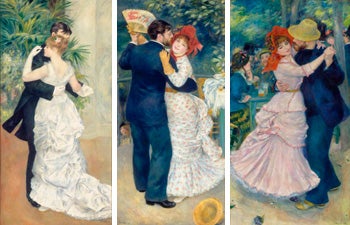
Dance in the City
Musée d'Orsay, Paris
Dance in the Country
Musée d'Orsay, Paris
Dance at Bougival
Museum of Fine Arts, Boston
1883
Between January and March Renoir works intensively in his Parisian studio on the three Dance panels—Dance in the City, Dance in the Country, and Dance at Bougival. The first two pictures are included in Durand-Ruel's midcareer retrospective of Renoir's work, which opens on 31 March. Dance at Bougival, the last to be completed, will be sent to London for an exhibition of Impressionist paintings organized by Durand-Ruel at the Bond Street Galleries of Dowdeswell and Dowdeswell.
-

1884
In May Durand-Ruel faces bankruptcy as a result of the collapse of the Union Générale bank. Renoir envisages a new painters' association whose aesthetics are based on the principles of "Irregularism."
1885
In the summer, Durand-Ruel accepts an invitation from James F. Sutton—son-in-law of the founder of Macy's department store—to exhibit 290 paintings and pastels in New York. He approaches Renoir, Monet, and Pissarro, each of whom offer their support.
In the autumn, Renoir works again on the full-length painting The Umbrellas, which he had started four years earlier but never completed. The painting is probably finished by the end of the year.

The Umbrellas
The National Gallery, London
1886
The Umbrellas is included among the thirty-eight paintings and pastels by Renoir that appear in the exhibition Works in Oil and Pastel by the Impressionists of Paris, held between 18 April and 30 June in two venues in New York: the American Art Galleries and the National Academy of Design. It is listed in the catalogue as "Rain in Paris." The painting was donated to The National Gallery, London, in 1917; this is only its second visit to the United States.


